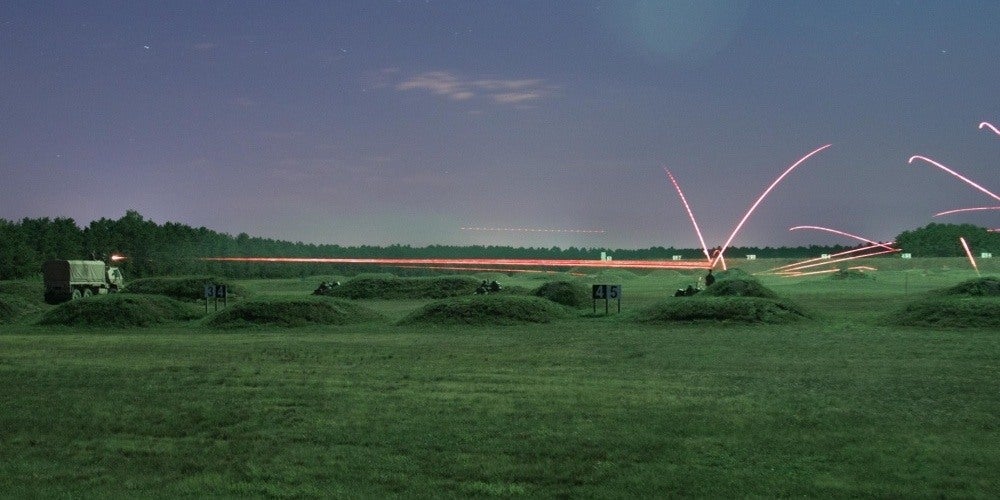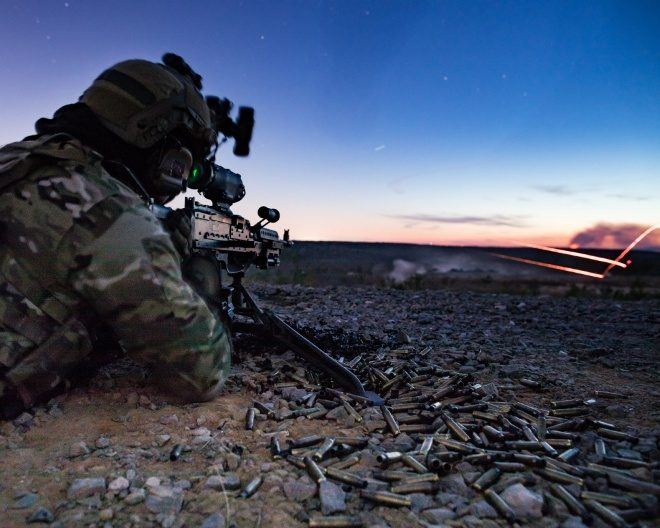A new set of US Department of Defense solicitations has been published on the website of a US government program called SBIR (Small Business Innovation Research). While browsing the list of projects, I came across a USSOCOM (United States Special Operations Command) call for designing spotting bullets that the command plans to deploy instead of the conventional tracers.
The solicitation is focused on 7.62x51mm spotting bullets for machine gun fire correction. The spotting projectiles, having an explosive payload, will make the bullet impact point much easier to detect visually thanks to the flash and smoke generated upon impact thus allowing the machine gunners to adjust the fire. The advantage of spotting bullets over tracers is that there are fewer chances of machine gunner’s position being compromised. In other words, the enemy won’t be able to locate the machine gunner as easy as it can be done by simply looking at the light trace coming from the bullet. Another advantage is the elimination of the issue of tracing compound burning out and failing to show the impact point at the target when engaging long-range targets.

JOINT BASE CAPE COD, Mass. – Soldiers from the 1058th Transportation Company, Massachusetts National Guard, conduct a night base defense live fire exercise under the illumination of a green flare during the Combined Arms Exercise: Patriot Crucible (August 1st, 2019). Photo by Staff Sgt. Steven Eaton
Here is the solicitation text in full:
TECHNOLOGY AREA(S): Air Platform, Ground Seaweapons
OBJECTIVE: The objective of this topic is to develop an innovative small arms marking round to replace tracers in adjusting machine gun fire.
DESCRIPTION: USSOCOM is seeking 7.62mm x 51 NATO spotting rounds to replace tracers for adjusting machine gun fire, both day and night, producing a flash and /or smoke signature visible at 800m-1200m. Current tracers allow gunners to observe the trajectory of the rounds and make aiming corrections without observing the impact of the rounds fired and without using the sights of the weapon. However, these rounds give away the gunners position, burn out before the maximum range of the machine gun and draws enemy fire. Replacing tracers with marking or spotting pyrotechnic rounds enables the gunner to directly control the impact on to the target, shows target coverage, and does not disclose the shooters location. This will increase the accuracy of machine gun fire, save ammunition, and increase gunner survivability. Key Attributes: Threshold (T), Objective (O) a. Visible day and night at 600m (T) -1500m (O) b. 7.62mm (T) , 7.62, 6.5mm and .338 (O) c. Ballistic trajectory match the 147 gr 7.62mm x 51mm M80 Ball (T), 6.5mm 130grs Open Tip Match (OTM), and 300gr 338 Norma Magnum OTM. d.. 90% flash on hard surfaces (T), 70 % function on soft ground (O). e. Fire hazard no worse than current tracers. f. Meet environmental, health and safety limits. While traditional incendiary projectile have some of these attributes, they have unacceptably thick jackets and tend to function only against hard surfaces. The pyrotechnic mix is optimized for incendiary effects rather than maximizing visual effects with minimum incendiary effects. Projectile weight, shape, combination of materials, and loading will have to be adjusted to achieve a ballistic match.
PHASE I: Conduct a feasibility study to assess what is in the art of the possible that satisfies the requirements specified in the above paragraph entitled “Description.” The objective of this USSOCOM Phase I SBIR effort is to conduct and document the results of a thorough feasibility study (“Technology Readiness Level 3”) to investigate what is in the art of the possible within the given trade space that will satisfy a needed technology. The feasibility study should investigate all options that meet or exceed the minimum performance parameters specified in this write up. It should also address the risks and potential payoffs of the innovative technology options that are investigated and recommend the option that best achieves the objective of this technology pursuit. The funds obligated on the resulting Phase I SBIR contracts are to be used for the sole purpose of conducting a thorough feasibility study using scientific experiments and laboratory studies as necessary. Operational prototypes will not be developed with USSOCOM SBIR funds during Phase I feasibility studies. Operational prototypes developed with other than SBIR funds that are provided at the end of Phase I feasibility studies will not be considered in deciding what firm(s) will be selected for Phase II.
PHASE II: Develop, install, and demonstrate a prototype system determined to be the most feasible solution during the Phase I feasibility study on a 7.62mm Marking Round.
PHASE III: This system could be used in a broad range of military applications where sensing and adjusting the target impact is critical. The new rounds are most applicable to effective long range machine gun and/or achieving second round hits when sniping at extreme long range.
I am sure we have active-duty service members and veterans among our readers. What do you guys think about replacing tracers with spotting rounds?
SBIR is a US government program that helps the domestic businesses to engage in Federal research and development programs which has the potential to be commercialized. This program particularly includes projects initiated by the Department of Defense. Besides the program that is the subject of this article, there are a number of other defense and small arms related programs in the list of solicitations. You can read the list and brief descriptions of other SBIR programs by clicking HERE.
Images from www.dvidshub.net
 Your Privacy Choices
Your Privacy Choices
